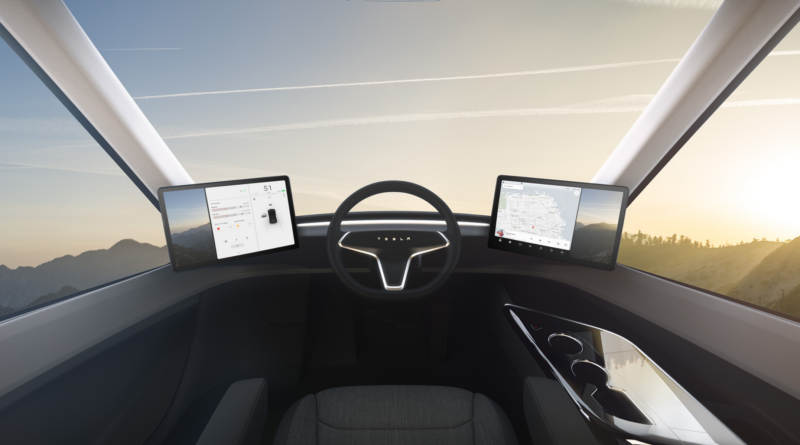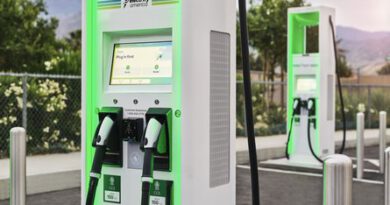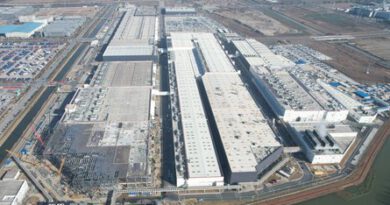How Justified is the Criticism of the Tesla Semi Truck?
Polish journalist and truck driver Tomasz Oryński, who left the country after 17 years in the UK because of the Brexit, wrote a Twitter thread at the beginning of December in which he shared his first impressions of Tesla’s new Semi Truck. Special attention was paid to the cabin design, the working and living space of a truck driver.
Oryński’s first criticism is the space in the semi truck. He finds it limited compared to other trucks, and also notes that Tesla’s Semi Truck gives away space here. It would definitely have been possible to create more space. He backs this up with a picture of the DAF XG+, where you can see a passenger seat, a bed and storage space underneath.
He then goes on to discuss the driver’s seating position, which is in the middle of the vehicle. According to Oryńskis, this would be bad in that it would make overtaking or looking ahead more difficult. Also, this seating arrangement would make it more difficult to hand out the car’s papers at the entrance gates or at a toll booth.
Also, he said, the doors are located behind the driver’s seat, which would require space for a small hallway from which to walk to the driver’s seat. This space could have easily been used for a bed or storage.
Because of the design of the right console, to exit on the right side, one would have to go around the driver’s seat to the rear. This creates a problem when the driver enters the cab with dirty shoes, because you drag it everywhere. With the traditional cab design, he said, the driver can take his shoes off right under the steering wheel, and the rest of the cab is clean, where he can then walk around barefoot.
He found the touchscreens particularly impractical. These offered no clues like physical buttons and levers, he said, and made it difficult to find the right switches while driving. Also, their glow – according to Oryńskis – distracted the driver’s attention and would give off light reflections.
According to him, the inclined windshield front has two disadvantages at once: the first in winter, because overnight the snow could settle there and the driver would have to get out and clean them. The second disadvantage is that in summer it would become very hot when the sun shines blazingly on the windshield. Also, according to him, they increase the blind spot, where my could quickly miss an obstacle.
Also, the driver’s cabin would narrow towards the front, resulting in longer brackets for the rear-view mirrors. These could then no longer simply be cleaned from the driver’s cab. The driver would have to get out or lean far out of the window. They would even be mounted too high, so that they could not be easily reached from the outside to clean them.
In summary, Tomasz Oryński says that the Tesla Semi Truck is a “rich boy’s toy” whose designers have no idea about the realities of logistics.
So how justified is this criticism? First of all, Tomasz Oryński has sat in or driven a Tesla Semi Truck just as often as I have: not once. All the information comes from research on the Internet, pictures and videos showing the vehicle in detail and in use.
Of course, Oryński is a bit ahead of me: he is a truck driver and knows the cab design of conventional and especially European trucks from his own experience. In this respect, his view is naturally shaped by these experiences and he certainly brings up some important points.
The Last Driver’s License Holder Has Already Been Born
How the radical disruption of the auto industry affects you―and how you can prepare for the soon-to-be “new normal”
The combined effect of autonomous driving, electric vehicles, and the sharing economy is on the verge of changing the auto industry―all within the next decade. And this tech/economics revolution will touch virtually every industry.
It reveals the disruptive technologies now taking shape and provides a timeline of when they will take hold. It examines the impact on the industry itself, as well as adjacent sectors, including jobs and professions, city and street design, hospitals, insurances, politics, security, hospitality industry, the oil industry, real estate, and society at large.
Get the book on Amazon.
Available Space
This is certainly a point that is worth discussing and depends on the intended use of the vehicle. As a Class 8 truck, you would certainly expect the truck to be able to drive thousands of kilometers and offer the driver all the comforts, including a bed. But you also have to know the special situation in the USA to be able to classify this correctly.
On the one hand, there are the long-distance drivers who, for example, drive 1,280 kilometers from Long Beach in California to El Paso in Texas. Or even further to Nashville in Tennessee, a whopping 3,200 kilometers. These are journeys that take 12 or 24 hours to complete and require overnight stays.
But then there are a whole series of distances that are quite short by U.S. standards, ranging from 100 to 300 kilometers, where the truck is driven back and forth between two camps. In testing, the Tesla Semi Truck drove back and forth for years between the Gigafactory in Reno, Nevada and the Gigafactory in Fremont, a distance of just under 350 kilometers, transporting battery packs and vehicle parts between the factories. Here, one crosses desert and snowy regions and several mountain passes. Similar routes, by the way, are the main use for the Tesla Semi Truck’s first customers, PepsiCo and FritoLay. Between a central warehouse to several stores a few dozen kilometers apart, but where you have to transport a lot of cargo.
In this respect, these criticisms, those with the bed, the possible dirt, the storage space, etc. to see. And there I can understand Oryński criticism well, if the intended use of the vehicle is also that of a living space on long journeys.
Seat Position
Oryński is particularly fond of the seating position, also because it would make it more difficult to hand out documents or pay at toll booths. As far as toll booths in the U.S. are concerned, they are in the process of disappearing completely and making way for electronic billing, such as FasTrak in California or the digital reading of license plates. This leaves the handing out of wagon papers and transport documents at the entrance and exit gates at warehouses and factories. This may still be a paper-based system in many cases today, where many transport companies do not want to change over for cost reasons, but it is like the chips on credit cards or the missing CD ROM drive on Apple computers back then. As soon as one party takes this step – take Walmart or Amazon in the USA – then everyone has to follow suit. Or there will be glaring incidents – such as the theft of hundreds of millions of credit card data – and the conversion costs will be cheaper in one fell swoop than further security breaches. Again, handling paper-based documents is increasingly becoming a cost trap, literally waiting to be converted to digital.
Incidentally, Oryński also addresses this point and sees little change there in the near future. But we also know from experience that these sometimes happen exponentially fast, see for example the credit cards with chips or the requirements that the pandemic forced upon us.
And I want to recommend them to you.All books are available on Amazon, from the Plassen and Beck publishing houses, or from your favorite bookseller.
They are even available as ebook here, for example.
Touchscreen
What is thus missing is the knowledge of how the semi truck’s cameras display an all-around picture of the situation around the vehicle on the criticized touchscreens. Instead of relying on mirrors, cameras are used. Three cameras are installed in each of the side mirrors, making the blind spot on the screens visible to the driver during overtaking maneuvers. Tesla passenger cars today do something similar, automatically superimposing the camera’s view on the touchscreen when the car is turning or reversing.
He is right about the lack of physical buttons that the touchscreen replaces, in that it makes it more difficult to find gearshift elements and touch them precisely. Especially when buttons change their position in a software update (like the one for the garage door in the last update) or are hidden in submenus that you have to click through first. But there is also voice input. And that makes searching for the function a thing of the past. Change radio station? Just tell the vehicle. Turn on the windshield wiper? The same way.
Note: the U.S. Navy is having some of the touchscreens on its combat ships switched back to physical buttons after several accidents, some of them fatal, occurred. The culprits were poor training of sailors on the one hand, and a UX that almost forced mistakes on the other.
Is the touchscreen blinding? Is it too bright, too dark, does it have specular reflections? In the four years I drove a Tesla Model 3, I was never once overcome with the desire to change the touchscreen brightness. Nor was I ever blinded by the screen. There is also a night mode where the screen automatically switches when the sun goes down, and conversely goes back to day mode when the sun comes up. That is not an argument against the touchscreen for me.
Wind Shield
The tilted windshield, as is common in passenger cars, can of course be criticized and the problems seen in snow or hot weather. But there are a lot of videos where Tesla drivers show how they preheat the driver’s cabin of the vehicle and thus the windshields are cleared even from larger amounts of snow. And the great thing is that no engine has to be running in the process, it’s purely the battery-powered heat pump that runs. The same applies to the summer. It’s important to remember that a Model 3 has a glass roof and still stays pleasantly cool in the summer.
Rear View Mirror
I honestly don’t understand the drama around this point. With what does Oryński clean his rearview mirror today? With his bare hand or rather with a mirror cleaner? You can get to it with the appropriate length of handle. And what he says is in principle only valid for the driver’s side mirror, because to clean the passenger’s side mirror, he has to stand up, or do I not understand something?
Weight & Charging Time
Not in this thread, but in others, the battery weight and charging time were discussed. There was talk of an alleged 40 ton battery weight and 2 days charging time. All this was not true. The battery with 1,000 kWh has a weight of about 5 tons, and to charge the vehicle to 70 percent (I assume 10 percent), you need just 30 minutes at the Gigacharger. Almost too short for a pee break and coffee, if you factor in the distances from the Gigacharger to the coffee machine (believe me, I have experience of this).
The battery weight itself does mean that 4-5 tons less load can be accommodated, supposedly putting more trucks on the road, but is that really true? Not if you look at the loading figures. In Germany, for example, every fourth truck drives empty on the roads, and truck utilization averages 50 to 70 percent. This is exactly where digitization would come to the rescue. Combined with sensors, the percentage could be raised to at least 80 percent, possibly even 95 percent. And that really takes trucks off the roads. The Tesla Semi Truck is fully digitized and would be the first candidate to take full advantage of this.
In addition to lower energy consumption, reduced collisions due to Autopilot and, in the future, FSD Beta, the ability to maintain speed when going uphill unlike diesel trucks, and recuperation when going downhill, there are so many cost advantages that the Tesla Semi Truck will become the vehicle of choice for both carriers and driver-owners.
Conclusions
Is the Tesla Semi Truck perfect? Certainly not. It’s Tesla’s first throw of a Class 8 semi truck, and a lot of thought and controversial changes have gone into it. Some will surely be retracted or adjusted, others will very quickly become the standard after initial controversy. The years will tell.
However, such initial assessment of new technologies always reminds me of the electric car haters I have encountered online and in reality. Little own experience with the new technology, but a strong and above all negative opinion. A number of arguments against the technology are advanced because this technology is seen as a direct continuation of the old one. From the range anxiety and the lack of charging stations, the allegedly so much energy sucking air conditioners and heaters that bring you death in the so frequent snow chaos on the highway. The alleged battery fires and explosion hazards, which is then hazardous waste in the first place, and the lack of familiar sound of a combustion engine. It’s unbelievable. It goes on with autonomous cars. I don’t want to lose control. They’re dangerous! And what if the grandma on the right and the baby on the left cross the road and the car can’t brake?
And all of them were the same, that they had never been in such a car before. The first time in an electric car, the first time in an autonomous car, the first own experience, and opinions turned 180 degrees. As much as you can think something through rationally and theoretically, practical experience beats everything.
Also, I am always skeptical of such critical threads when not a single positive point can be identified by the critic besides the weak points, not a single understanding of the change is put forward. The automobile in 1890 had only weak points compared to the horse (noisy, smelly, expensive, unreliable, no gas stations), while for the horse everything was there (relay, hay, water, vet, horse shit removal service…). And yet, the horse disappeared from our roads as a means of transportation.
The Twitter thread by Tomasz Oryński should be viewed with exactly this caution. He is certainly right about some of the points made, but there are also too many among them that he will not understand as unfounded until he has been on the road himself in a Tesla Semi Truck. Whether those will be the ones he lists or the ones I feel that way will only be seen in practice. For that we should wait for a field report from a Tesla Semi Trucker, until then everything is just speculation and envy of the “rich guys’ toys”.
Le dernier titulaire d’un permis de conduire est déjà né
L’automobile telle qu’on la connaît va disparaître. L’intelligence artificielle, la voiture électrique, la voiture autonome et l’économie du partage sont en voie de révolutionner l’industrie automobile au cours de la prochaine décennie. Cette révolution technico-économique affectera tous les domaines, pas seulement celui de l’automobile. Le dernier titulaire d’un permis de conduire est déjà né révèle les technologies perturbatrices qui prennent forme actuellement et propose une chronologie du moment où elles s’imposeront. L’auteur, chercheur en technologie, communique sa vision de l’industrie automobile de demain et l’impact sur les emplois notamment dans l’industrie automobile et pétrolière, l’environnement, les sciences, l’urbanisme, les hôpitaux, les services policiers et la sécurité, la politique, les lois, l’hôtellerie et la restauration, l’immobilier, l’économie mondiale et la société en général. Des dizaines de milliers d’emplois seront supprimés définitivement dans plusieurs domaines, mais la nouvelle économie en produira deux fois plus selon les experts. Découvrez comment ces bouleversements dans le monde des transports, notamment les robotaxis, affecteront vos vies, votre budget et comment vous y préparer, et pourquoi c’est une bonne chose.
This article was also published in German.




